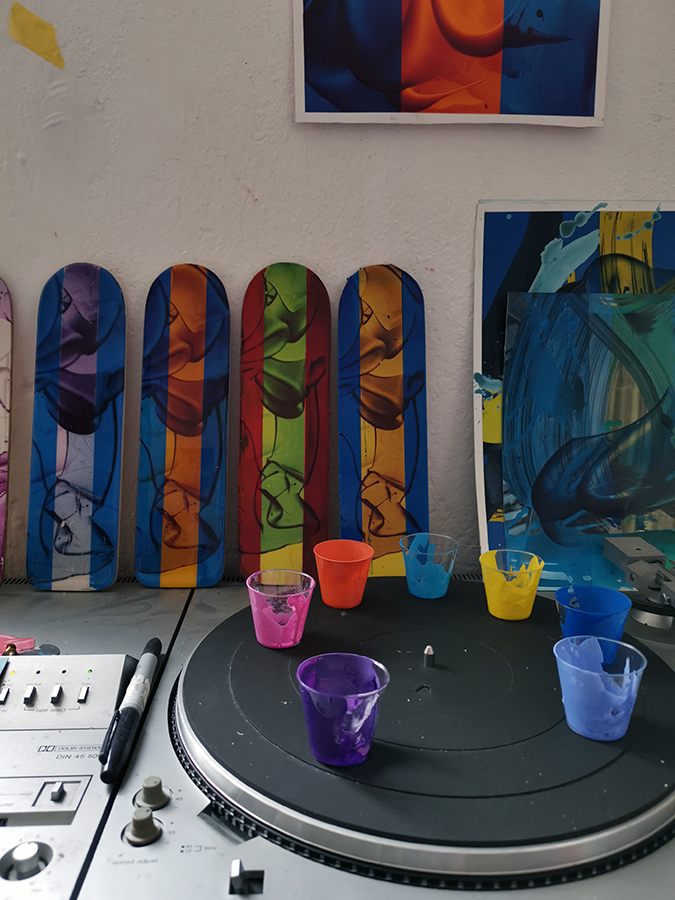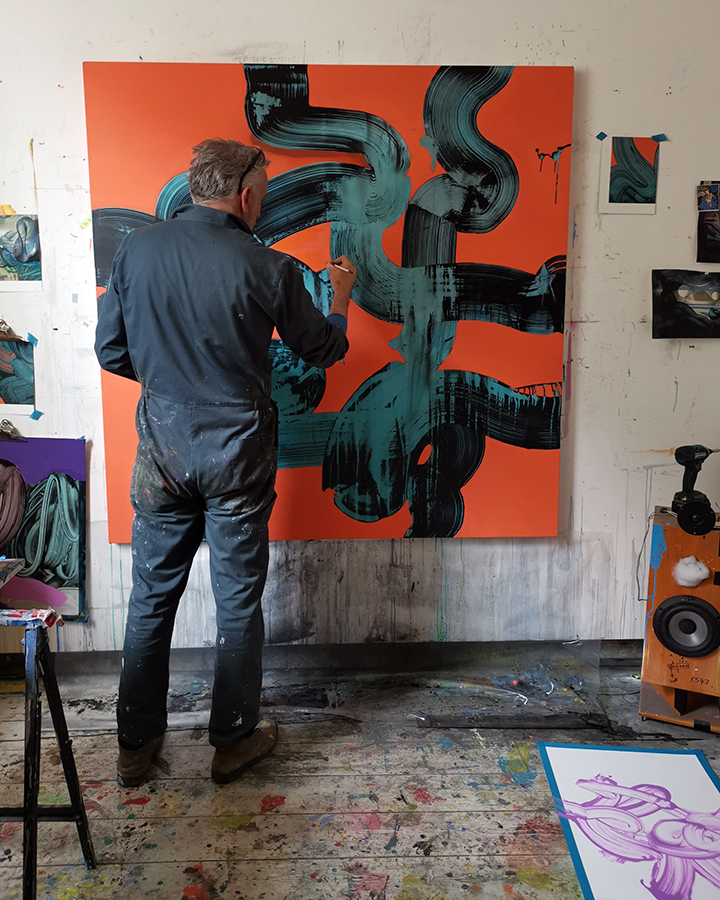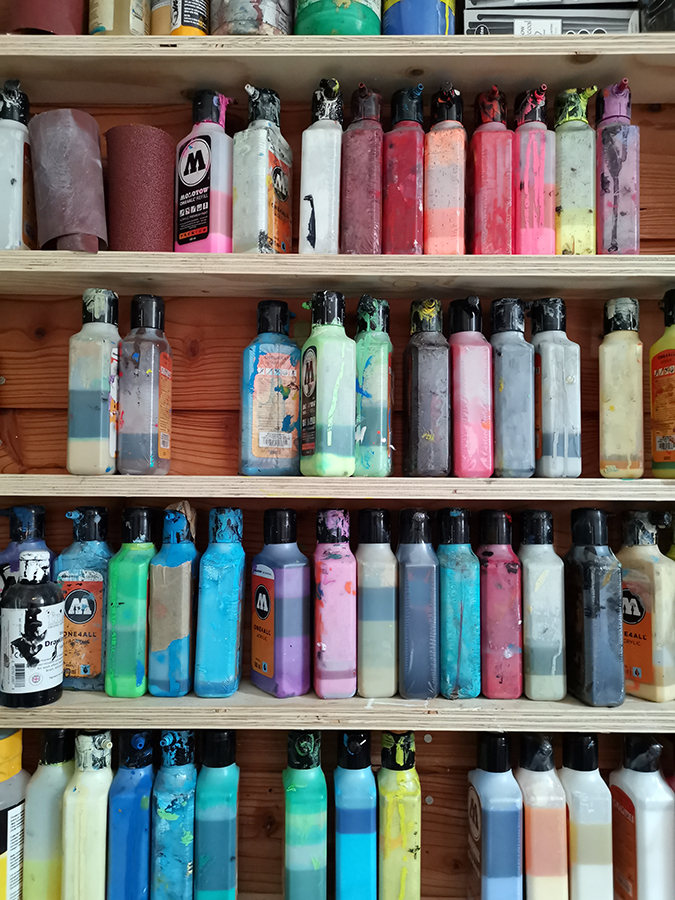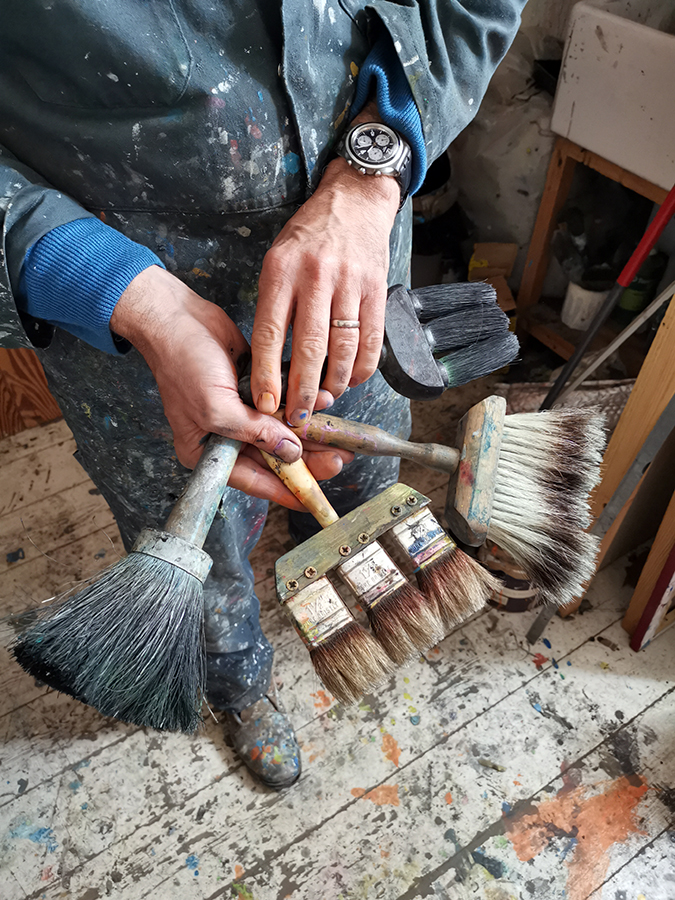Where did your interest in art initially come from?
My dad was an artist so that was a big influence. Our home was full of artworks and art books. As a kid it was great, he’d take me out into the landscape and set up his easel. I’d just sit at his feet, do a bit of drawing then wander off and play in the fields. It’s a lovely memory.
I grew up in the West Midlands, in the Black Country. Our house backed onto a wood. As a moody teenager, I was often left alone at home. I used to just lie on the living room floor, listen to music and stare out of the window for ages. The positive and negative outlines of the trees against a winter sky were just gorgeous. This all ties in with the work I do now. Music is still a big part of how I work, too. It fires my imagination.

When did you first start experimenting with abstract art?
I left school at 16 and did my A-Levels at an art college. Suddenly it felt as though everything fell into place. I went on to do my foundation and degree at Loughborough University then did an MA at Nottingham University. I started doing abstract work quite early on – I used to pile furniture into the corner of a room and start to paint the shapes and forms and the negative spaces. I found it fascinating and started to go in that direction.
What has had the most influence on your work?
Cartoons play a large part in the sort of work that I do. A number of years ago I was clearing out my parents’ house. I picked up a book and was flicking through the pages, and was stopped in my tracks because it looked so similar to my own colour schemes and compositions. It was a comic annual from the 1970s, and I now realise that that my desire for these bright colours, these marks and these sorts of compositions were all in those annuals.
You’re also an Animatronics Designer. How did that side of your work weave in?
Following my MA I felt a bit lost. I didn’t know where I was going with my work, I was broke and I wanted more life experiences too. Fortunately I met a theatre director who was looking for a prop maker. I volunteered, although I didn’t know what I was doing. That led to me getting a job with Spitting Image in London. Those were the fledgling days of animatronics. It was an amazing time. It was like an extension of art college hanging out with a bunch of creatives making cool stuff.
When I was designing animatronics I’d look at the spatial complexities of things. When you take the back off some animatronics, it looks super complex. It starts with base elements and then gets more and more complicated as you build. I build my artwork in the same way. I am always communicating with my hands, whether it’s in paint or manipulating a piece of metal or wood, it all feels part of the same language.

Porthmeor Studios has a prestigious history, how did you come to be here?
There were very few studios in this area when we first moved down in 2004, so I took what I could. Then I was awarded the John Moores painting prize in 2016. It’s the toughest art competition to get into, seen as the Oscars of British painting. With that I was able to apply to take on Patrick Heron’s studio space here at Porthmeor Studios. The little studio I’m in now is actually the rear end of Terry Frost’s studio. I have always been a fan of Patrick Heron and Terry Frost so it is amazing to be here.
What other artists’ work are you drawn to?
The gestural marks of artists like Albert Irvin fascinate me. They record a moment in time. They are a tangible record of the artist’s application of the paint. It’s the same with Jackson Pollock or John Hoyland. I think there’s a confidence in the watery, splashy mark – a confidence in the execution of their work. I really enjoy seeing their work in galleries – when you stand in front of one of their paintings you’re in that electric, fizzy space in which the artist stood too and created those marks.

The colours in your paintings are so vibrant, what media do you most enjoy using?
Every painting I create is a visual space I want to explore. And every media has got its signature, its language and vocabulary. I tend to use a lot of materials that aren’t available in art shops out of my desire to find paints or inks that have maximum intensity or opacity. I started to explore graffiti materials recently.
I use a combination of water based materials and oil based materials over the top. I’m also a very impatient person and just want to get on with creating work all the time, so I like to use an oil alkyd which is a rapid-drying oil media. I can get really nice gradations of tone with it. Some people think it’s been printed, but then they see that there’s more to it than that.
You have developed some unique mark-making techniques, can you share how you approach creating your artworks?
I often begin a painting on the floor, then move it to a wall. I make my own palette knives so I can make really big marks. I modify my own brushes, too. They make a unique mark that you won’t see anywhere else. I often take some of these brushes to Newlyn to show the students. Many people who come to the courses have only ever used small paintbrushes, so they’re not used to the physicality of using brushes like these; it’s a very different way of working. I can usually spot the people who need a little bit of liberation, and I’ll suggest they use one of these to free up the way they work.

Can you tell us a bit about your Exploring Abstraction Course? Is it suitable for everyone?
I enjoy imparting what I know. Some artists are a bit secretive about their techniques and methods, whereas I’m quite open to telling everybody that’s interested! This course is an opportunity for people to experiment with a range of techniques they’re unfamiliar with and to explore a new visual language. It’s great to see people step out of their comfort zone and explore new materials and tools. We have a lot of fun together.
The course is for everyone. That’s one of the things I find most interesting about teaching at Newlyn. Sometimes you find that some of the students have been an exhibiting artist for 25 years and you wonder why they’re there and what you can teach them that they don’t already know! Then sometimes you’ll meet someone who’s had no experience whatsoever, and they pick up a brush and this raw talent comes out. One student I remember had an extraordinary gift. I asked her how she found the course, and she said it was life changing. So that’s amazing isn’t it, to be able to do something like that for somebody.
- Interview by Kari Herbert